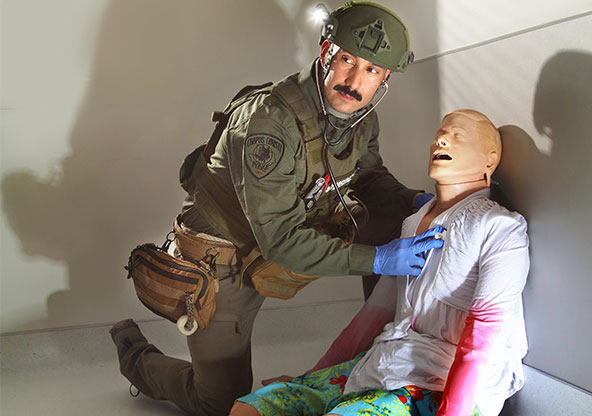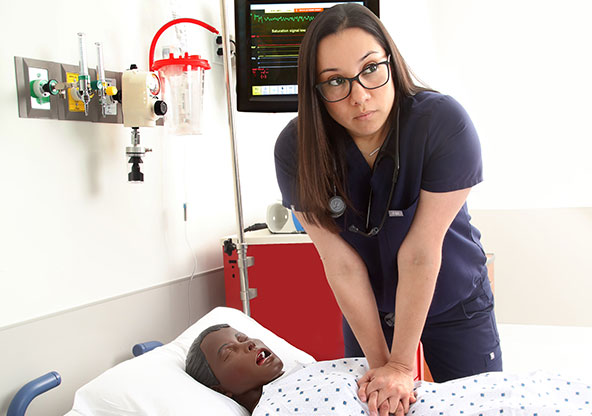Simulation Center Prepares Emergency Workers
Oscar Medina, a SWAT medic in Corpus Christi, is in a dark, crowded room with a loud sound coming from the back of the building.
Medina needs to quickly find people who suffered severe injuries and start treatment. But there is such a large crowd in the room it's difficult to find them, and the loud noise is making it difficult to concentrate.
"When you're in these simulations, it feels so real. It's like you're in an actual emergency," Medina said.
Medina is a participant in a rigorous training program designed to replicate high-stress emergency scenarios, ensuring that responders like him are prepared for the intensity and unpredictability of their roles.
The CHRISTUS Health Simulation Institute at Spohn trains emergency personnel in Corpus Christi. The sim lab fosters learning with professionals from different specialties so they can collaborate, enhance teamwork, communicate, and prepare for real emergencies.
Focusing on Learning with Immersion
The sim lab emphasizes learning in an immersive training environment.
The specific training Medina received in the simulation lab included difficult intubations, low light scenarios, high noise scenarios, dealing with multiple people and patients, and scenarios involving physical challenges such as carrying a trauma patient without injuring them.
The program is led by Dr. Shani Italiya, an emergency room physician at CHRISTUS Spohn and medical director at the simulation center in Corpus Christi.
"The goal of our simulations is to create experiences that mimic real-life scenarios as closely as possible," Dr. Italiya said.
Learning New Skills
In the 14 years that Medina has worked for the fire department, he has never received training in advanced airway management techniques.
The training in the sim lab included mastering traditional methods using basic equipment and utilizing a glide scope for camera-assisted intubation procedures. He also learned to use a cricothyrotomy, a procedure involving a surgical incision to secure an intubation tube directly into the patient's airway. This procedure is rarely used.
“Thank God I have not had to use it in my five years on SWAT, but it is always good to be prepared,” Medina said. "You hardly get this type of training anywhere."
Building Urgency into Training
Dr. Italiya noticed that most training lacks a sense of urgency.
He thought that making simulation training as real as possible would solve the problem. He first tried this with a nosebleed that would not stop, which patients go to the emergency room for.
The treatment is to stick a Rhino Rocket® up the patient's nose, which is a large tampon that can eventually stop bleeding. These types of scenarios don't happen often in emergency rooms, but it is something teams want to be prepared to treat.
To train for this, simulations will use a mannequin with no blood. The participants will need to say aloud, "The patient is now bleeding from the nose." Afterward, they will walk over slowly to the inflatable tampons, grab one, and slowly puff it up.
To make the scenario more urgent, Dr. Italiya used an out-of-commission CPR mannequin and ran large tubing through its chest and out of its nostrils. He connected the tubing to a bag of red-dyed fluid hidden behind a curtain.
When they started, they opened the bag of red dye, causing the red fluid to pour out.
"You saw a sense of urgency where everyone ran, scrambled, tried to hold pressure to stop the bleeding," Dr. Italiya said. "It was that much more real, and so we try to do everything as real as possible."
Training the Experts
The big question is, how do you help experts who are already highly experienced and knowledgeable?
By creating immersive settings, complete with actors and realistic props like mock ambulances, Dr. Italiya said that participants are more engaged and committed to learning, maximizing the educational value of each simulation.
And all of it is to ensure patients are cared for quicker and more confidently.
Medina said he does not see extremely stressful situations as often as he sees the regular EMS calls in his regular jobs.
"Having the residents and the doctors go over some of the things that we did and some of the things we could have done differently helps us assert more confidence," Medina said. "It is definitely beneficial."
Join CHRISTUS Health
Looking for a nursing position? We'd love to hear from you.


